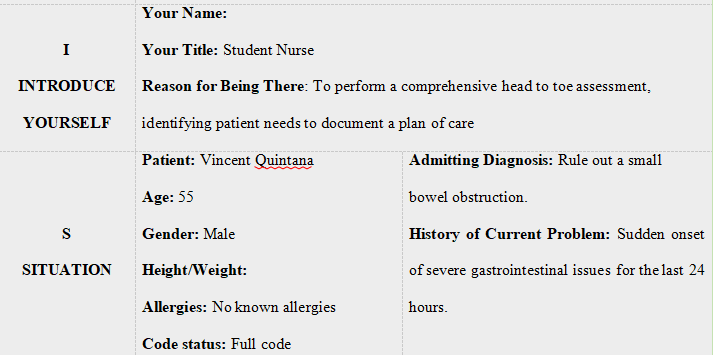NR 226 week 7 Virtual Simulation Vincente Quintana’s Case Pre-work Submission
The is the video Transcript detail about the patient Vincente Quintona’s
Please the ISBAR format and the reflection paper 3 3 question simple answers about the patient I will attached both below
Hi there. I’m glad to say you were early for your clinical day. It’s going to be a busy day, so let’s get started right away. I’ll meet you in the conference room for pre-briefing. Today’s patient is Vincent Quintana. Mr. Quintana is a 55-year-old male being directly admitted from the urgent care for a sudden onset of severe gastrointestinal issues. His symptoms began about 24 hours ago. His admitting diagnosis is a rule out a small bowel obstruction. In planning the care for Mr. Quintana, what are some of the primary assessments we’ll need to focus on because he has a suspected small bowel obstruction. >> Primary assessment should include vital signs, pain assessment, and a focused gastrointestinal assessment, including the last bowel movement. We should also anticipate and review relevant diagnostic exams and lab results. >> Yes, I agree. Reviewing the labs will give us more information about Mr. Quintana current state of health. Once we complete our assessment, what type of nursing interventions should we anticipate? >> Patients experiencing a bowel obstruction often have abdominal pain, nausea, and vomiting. One of the first aspects I would address would be the patient’s pain and comfort. He may have a fluid and electrolyte imbalance requiring intravenous fluid replacement and antiemetic medications. It’s not unusual for a patient to require the insertion of a nasogastric tube for decompression of the accumulation of gas and fluids proximal to the blockage. >> Yes. I would address pain and comfort first as well. I once cared for a patient in a similar situation to Mr. Quintana. She required surgical intervention. A nurse caring for a patient with a small bowel obstruction should be prepared to implement preoperative orders and postoperative teaching plan to prevent post-op complications. With my patient, I was concerned about possible complications by dehydration, hypovolemia, electrolyte imbalance, and peritonitis with possible sepsis. >> Thanks for sharing that experience. What kind of medications did you administer? >> I’m trying to remember. I believe I administered hydromorphone, ondansetron, and IV fluids. Whenever I administer hydromorphone, I am always careful of the side effects which are respiratory depression, nausea, and constipation. In fact, my patient had respiratory depression and I had to call the health care provider to get an order for an naloxone. The naloxone reversed the effect of the opioid and her respiratory rate returned to normal limits. >> As nurses, there are several non-pharmacological comfort measures we can implement for patients experiencing nausea and pain. Some of my favorites are applying a cool washcloth to the forehead, neck, or chest. I’ve also dim the light, promoted meditation and guided imagery, and if the hospital allows, use essential oils. >> Let’s transition and talk about your role in this simulation. You will be the staff nurse at the hospital who will be performing a complete head to toe assessment, identifying patient needs, prioritizing a documenting a plan of care. Using the SBAR components, you are expected to document your findings as a nurse’s notes. Following that virtual simulation in a human, you will participate in a debriefing. Remember, the goal of debriefing is to summarize your virtual clinical experience and identify the key takeaways that will enhance your clinical skills and judgment. >> Let’s head up to the unit and meet your patient.
Answer Preview

APA Format 428 words
